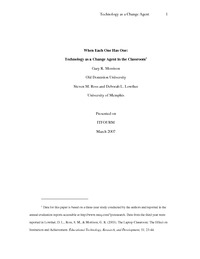When Each One Has OneTechnology as a Change Agent in the Classroom
Gary R. Morrison, Steven M. Ross, Deborah L. Lowther
Publikationsdatum:
|
 |
 Diese Seite wurde seit 2 Jahren inhaltlich nicht mehr aktualisiert.
Unter Umständen ist sie nicht mehr aktuell.
Diese Seite wurde seit 2 Jahren inhaltlich nicht mehr aktualisiert.
Unter Umständen ist sie nicht mehr aktuell.
 Zusammenfassungen
Zusammenfassungen
Technology has long been viewed as a means to deliver instruction since the
lantern slide projector was introduced into the classroom in the late 1800’s. This
conception of technology has guided its use through the last century with the introduction
the overhead projector, 16mm film projector, television, and more recently
microcomputers and PDAs in the K-12 classroom. The U.S. Congress added support to
this approach with the passage of the National Defense Education Act as a reaction to
Sputnik in 1957 that resulted in the placement of overhead projectors in many K-12
classrooms to improve instruction. While Clark’s (1983) research suggests that
technology as a mere delivery device does not enhance learning (separate from the
associated instructional strategies), school districts continue to purchase additional
technology and new technologies to improve student achievement with little if any
documented return on the investment. Recent data indicate that 61% of the homes in the
United States and 93% of the instructional classrooms have access to computers
(Statistical Abstract of the United States, 2007). Yet, recent research indicates that fourth
and eight graders are more likely to use computers to play games while eleventh graders
are more likely to write papers (Day, Janus, & Davis, 2005).
While many researchers agree with Clark and have abandoned the media
comparison research agenda to identify learning gains attributable to technology, a
question still remains as to what effects technology might have on instruction and the
classroom environment. In this paper we will examine how a technological innovation
affected changes in the instruction and the classroom environment that subsequently
resulted in improved student achievement and performance during a three-year study.
Von Gary R. Morrison, Steven M. Ross, Deborah L. Lowther im Text When Each One Has One (2007)  Dieser Text erwähnt ...
Dieser Text erwähnt ...
 Begriffe KB IB clear | One-to-One-ComputingOne-to-One-Computing
,  Problemlösefähigkeit Problemlösefähigkeit problem solving skills problem solving skills
|
 Dieser Text erwähnt vermutlich nicht ...
Dieser Text erwähnt vermutlich nicht ... 
 Nicht erwähnte Begriffe | Ein Notebook pro StudentIn (ENpS), Notebooks an Schulen |
 Zitationsgraph
Zitationsgraph
 Zitationsgraph (Beta-Test mit vis.js)
Zitationsgraph (Beta-Test mit vis.js)
 7 Erwähnungen
7 Erwähnungen 
- Implementation and Effects Of One-to-One Computing Initiatives - A Research Synthesis (William R. Penuel) (2006)


- Ubiquitous Computing in K-12 Classrooms - A Systematic Review (Edward C. Bethel, Robert M. Bernard, Philip C. Abrami, Anne C. Wade) (2008)

- Integration von Tablet PCs im Rahmen des Medieneinsatzes einer gymnasialen Oberstufe - Endbericht (Björn Eric Stolpmann, Stefan Welling) (2009)


- Bildung und Schule auf dem Weg in die Wissensgesellschaft (Birgit Eickelmann) (2010)
- Examining the impact of off-task multi-tasking with technology on real-time classroom learning (Eileen Wood, Lucia Zivcakova, Petrice Gentile, Karin Archer, Domenica De Pasquale, Amanda Nosko) (2011)


- Individuell fördern mit digitalen Medien - Chancen, Risiken, Erfolgsfaktoren (Bertelsmann Stiftung) (2015)
- Individuelle Förderung mit digitalen Medien. - Handlungsfelder für die systematische, lernförderliche Integration digitaler Medien in Schule und Unterricht (Richard Heinen, Michael Kerres) (2015)


- Individuelle Förderung mit digitalen Medien. - Handlungsfelder für die systematische, lernförderliche Integration digitaler Medien in Schule und Unterricht (Richard Heinen, Michael Kerres) (2015)
- One-to-One Computing and Student Achievement in Ohio High Schools (Nancy L. Williams, Karen H. Larwin) (2016)
 Volltext dieses Dokuments
Volltext dieses Dokuments
 |  When Each One Has One: Artikel als Volltext ( When Each One Has One: Artikel als Volltext ( : :  , 68 kByte; , 68 kByte;  : :  Link unterbrochen? Letzte Überprüfung: 2021-03-21 Letzte erfolgreiche Überprüfung: 2016-05-28) Link unterbrochen? Letzte Überprüfung: 2021-03-21 Letzte erfolgreiche Überprüfung: 2016-05-28) |
 Anderswo suchen
Anderswo suchen 
 Beat und dieser Text
Beat und dieser Text
Beat hat Dieser Text während seiner Zeit am Institut für Medien und Schule (IMS) ins Biblionetz aufgenommen. Beat besitzt kein physisches, aber ein digitales Exemplar. Eine digitale Version ist auf dem Internet verfügbar (s.o.). Aufgrund der wenigen Einträge im Biblionetz scheint er es nicht wirklich gelesen zu haben. Es gibt bisher auch nur wenige Objekte im Biblionetz, die dieses Werk zitieren.









 Biblionetz-History
Biblionetz-History